The Horizon 202 is a fixed-lens, fixed-focus 35mm camera with a swinging lens. It’s capable of taking panoramic photos with a genuinely unique perspective. We tried it out, shooting around our office, and learned a few things. Let’s talk about the Horizon 202!
The Camera

Build Quality
The camera itself is a heavy hunk of plastic, but it’s better built than it may let on. The internals are mostly metal and use a similar drum mechanism to other swing-lens cameras like the Widelux. It’s a solid-feeling camera despite the plastic and the reputation of poor quality that other Soviet cameras have garnered.
The Mechanisms
The Horizon 202 is a fully mechanical camera, so no batteries are required. When you advance the film, the camera preps itself by pulling the lens back to the starting position. This also reveals the tabs for picking shutter speeds and apertures.

Immediately, one of the weak points of the Horizon 202 becomes apparent–there aren’t many options for shutter speeds. There’s a fast range (1/60s, 1/125s, and 1/250s) and a slow range (1/8s, 1/4s, and 1/2s), toggleable with a switch on the back left of the camera. That’s just not much, (even compared to something like the Widelux, which has three ranges) so this camera may struggle in extremely bright or extremely dark situations. That being said, the shutter speeds work a bit differently on a swing-lens camera like this.

The Horizon 202’s shutter means that each section of the film will be exposed for the amount of time selected. It aims to expose the left, center, and right of the frame the same, so it ends up taking much more time than the shutter speed selected. For example, selecting a 1/8s shutter speed results in an exposure that takes longer than a second in real time.
So yes, the Horizon is a limited camera in this sense. Truthfully, it’s best used on a tripod except when using either 1/125s or 1/250s. But these limitations allow for some incredible perspectives that aren’t possible with a more traditional camera.
In Operation
Using the Horizon is a relatively simple affair. After picking your shutter speed and aperture combination, the viewfinder gives a good view of what the lens will capture. It’s not the best finder, and it’s prone to flares, but it’s hard to capture the wideness of what the lens captures in a way that looks good from all angles. It also has a built-in bubble level to keep the camera steady, which you’ll want to do. With a frame as wide as the Horizon, being off by a degree or two becomes very noticeable.
But before we take a photo, we need to load the film. Opening the back reveals a curved film plane. This makes sense since the lens rotates and we want the light to hit the film straight on from every angle. The difficult part is actually getting the film inside it. There’s a diagram on the back door that shows how the film should feed through the camera, but it involves feeding it underneath most of the spools and through some very tight places. Maybe you’re a better loader than I am, but I found it difficult.
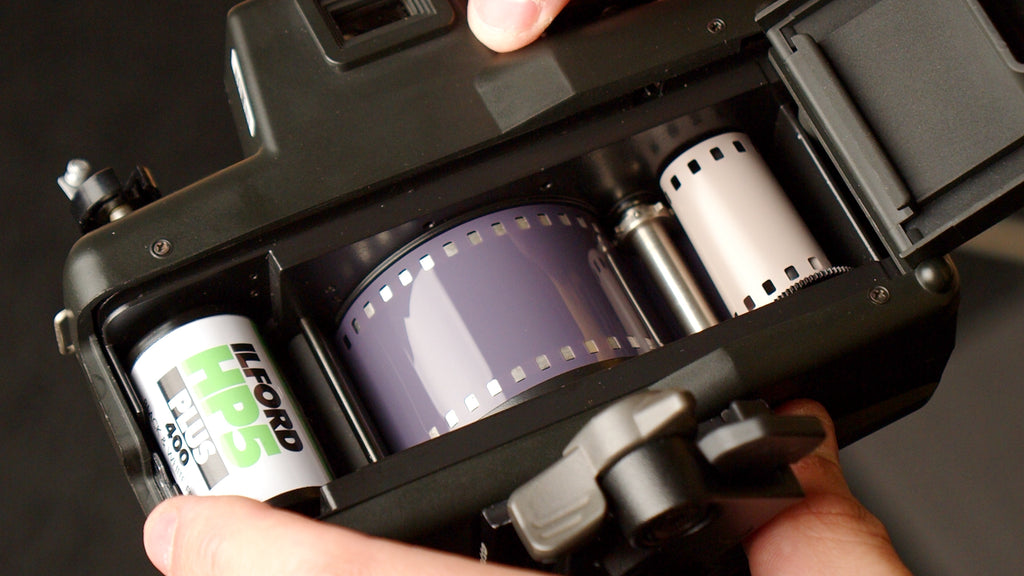
Even once I had the film attached to the take-up spool properly, it didn’t inspire confidence. The spool didn’t seem to hold the film tightly, despite it being properly attached and winding normally. I did this without the back door on, though, so maybe that’s why. The back door likely helps hold the film in place.
I say this because, once I got the back door in place, the camera worked normally. I didn’t feel any weird resistances, skipping, or tearing that might be indicative of bad film loading or poor advance mechanisms. Every time I pulled the advance lever, it felt pretty smooth, albeit long. Even that is probably a good thing, though, as it forces you to slow down. The Horizon 202 is not a fast camera.
It is, however, a loud camera. Especially when using slow speeds, which take a while to finish, the camera will alert anyone nearby that a photo is being taken. There’s just a lot of motion happening as the lens swings around, and adding the self-timer-assisted slow speeds adds that classic whirring sound on top of it. It’s not subtle, and little effort was made by the Soviet designers to dampen the sound.

Regardless of its limitations, just playing with the Horizon makes you think about the possibilities. When this 202 came through our process, I knew we should play with it and make some content to showcase this awesome camera.
Our Time with the Horizon 202
Jeff Bridges Portraiture
The first thing we wanted to try was to mimic the portraiture of Jeff Bridges. The actor, famous for his roles in The Big Lebowski and Crazy Heart, is an avid film photographer. He has published multiple books using a Widelux camera and is working with Silvergrain Classics to bring the Widelux back to life.

One unique way he uses the Widelux is to create double portraits. By taking advantage of the slow swinging lens, Bridges can capture the same subject twice in one frame. He does this by moving the camera midway through the exposure.
Basically, you have the subject in the left part of the frame when you fire the shutter. Once the lens passes them, you quickly twist the camera so the subject is in the right part of the frame. If done correctly, you get two versions of the subject. By having them make two different faces, you get a nice sort of one-frame-diptych.
We wanted to try this, of course. We shot a few of ourselves and some coworkers that felt like we had done it right, but the thing about film photography is that you can’t be sure until the film is drying in the darkroom. Looking back, it seems we were too eager to twist the camera and ended up cutting off the first version of our subject with remarkable consistency. I blame it on adrenaline. It’s exciting once the lens starts moving!

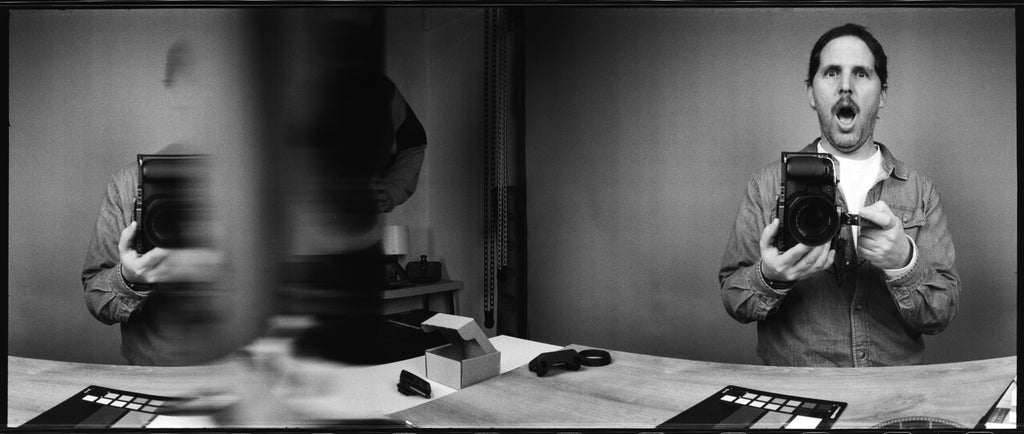
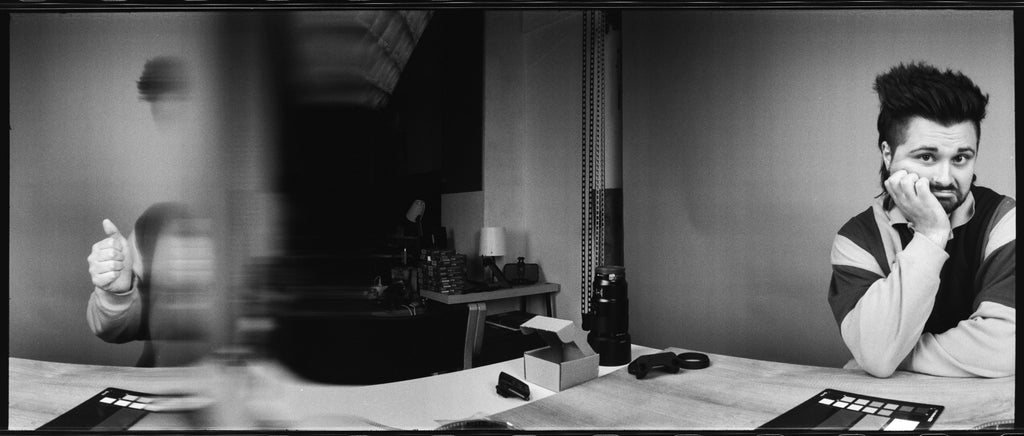
As you can see, the potential is there. We just needed to give it an extra breath before our twist and it would’ve been fine. I’m sure Mr. Bridges made a few mistakes along the way, too.
Normal Panoramas
After our portrait session, we decided to finish the roll by walking around our office and taking more standard panoramas. When compared with a “normal” panoramic camera like the Hasselblad XPan or a 35mm back on a 120 camera, the Horizon gives a noticeably different result.
Because of the swinging lens, the Horizon captures each section of the film from straight-on instead of at an angle. This is actually very similar to how our eyes work as we move them from side to side, but the Horizon has had the peripheral vision of its lens vastly reduced. It actually works a lot like a modern photo or document scanner, taking a wide sensor and pulling it across the frame rather than capturing the entire thing at once.

This means it's possible to stay in frame almost the entire time, which I attempted to do in this photo.

I did a crab walk, it was funny.
After that, we took some photos of the people in our office just doing their work. Our office isn’t particularly dim, but we had to be careful with our shutter speed and aperture combinations in order to get everything in focus. That’s because the Horizon 202 is a fixed-focus camera.
The only way to adjust the focus is by changing the aperture, so to get close to our subjects we needed a more narrow aperture and, thus, slower shutter speeds. Here’s the table of minimum focus distances relative to the aperture with the Horizon 202.

As you can see, we have to keep our subjects pretty far away if we want to use a wide aperture or fast shutter speed. This can make it hard to photograph people in a dim environment, as people tend to move around even if they’re told not to. That’s why we had our technicians standing pretty far away and made sure they knew to stand still when we photographed them.

Moving objects in general are a huge weak point of the Horizon. Because of its design, it just can’t capture them in a way that looks normal. But that’s not necessarily a bad thing. Like most specialty cameras, the Horizon can make excellent photos if you work within its limitations or create situations where those limitations become advantages.
Like this portrait of me from below. The unique perspective of the Horizon gives me a slightly warped look that wouldn’t exist with a wide-angle lens or a normal panorama camera. It makes an interesting photo out of what would otherwise be just me standing in our office.
Some Concerns
While we didn’t notice any serious exposure issues while testing the Horizon 202, there are a few things you should be aware of if you buy one for yourself. There can be issues with exposure unevenness and light leaks.
Exposure unevenness happens if there is dirt, dust, or uneven lubricants in the swinging drum mechanisms inside the Horizon. It’s exactly what it sounds like–the exposure is uneven. The swinging lens moves too quickly or too slowly in certain parts of its movement, causing one part of the photo to be darker or lighter than the rest. It’s easy to test for this by shooting a few test photos onto a white/gray background. Unfortunately, even our shutter testing machines aren’t equipped to test a swing-lens camera like the Horizon.
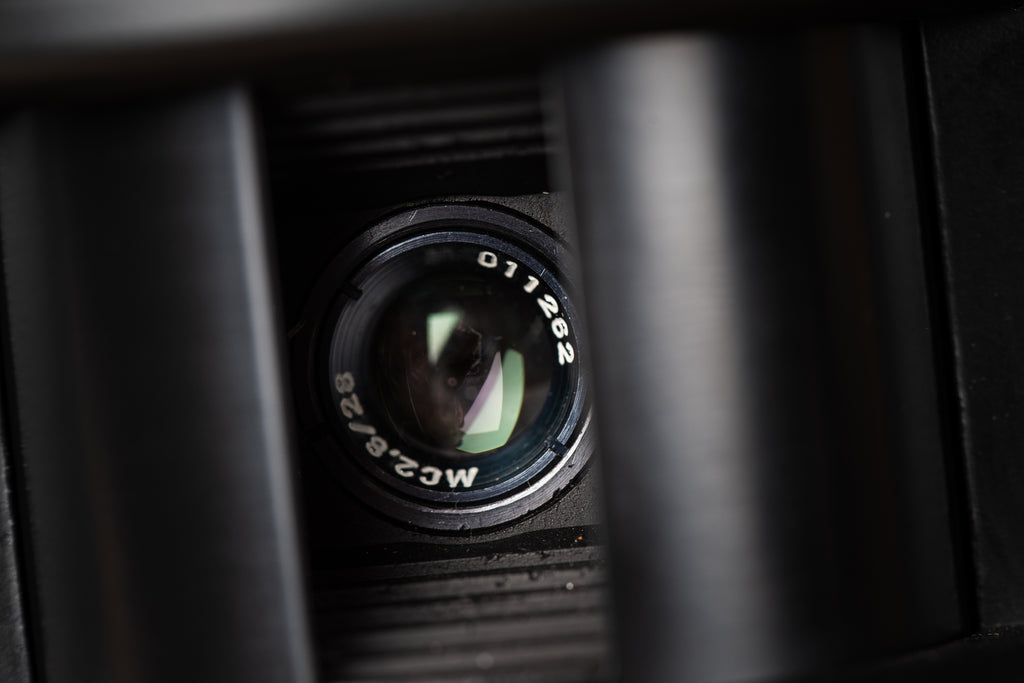
The other issue is light leaks. While there are no light seals inside the Horizon’s film back, the swinging mechanism opens up many possibilities for light to get through the body and onto the film in the wrong way. You can see we had a small lens leak on the photo of our technicians. This isn’t easily fixable but seems to affect photos very intermittently depending on the subject. Shielding the camera from light when not in use can prevent some issues.
Conclusion
So, it’s a finicky Soviet camera. It has plenty of strange quirks and things to be aware of, and its certainly limited even compared to other panorama cameras. Regardless, though, the Horizon can make photos that very few other cameras can. It brings a totally unique perspective to the table and requires a slow-paced, thoughtful style of shooting. I wouldn’t carry it around every day, but there are some creative applications where it’s the best tool for the job.
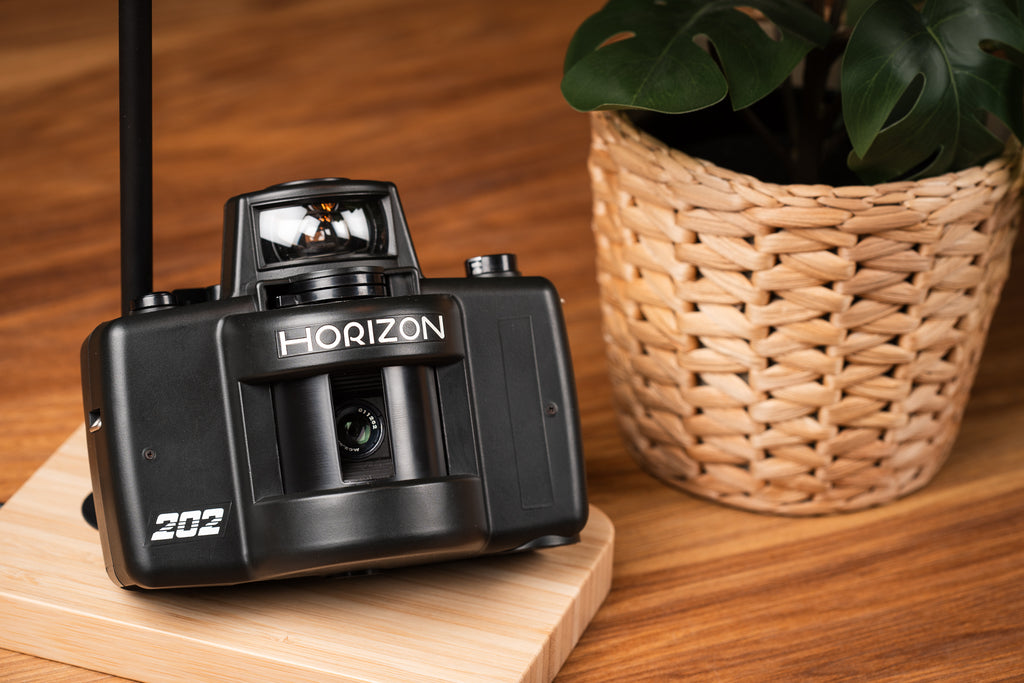
If you can get your hands on a working one, I highly recommend it. The entire package made me think creatively about my photography and how I could work within the camera’s limitations to create things I wouldn’t be able to create otherwise. That’s a pretty cool feeling to get from a hunk of Soviet plastic.





